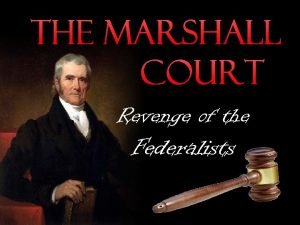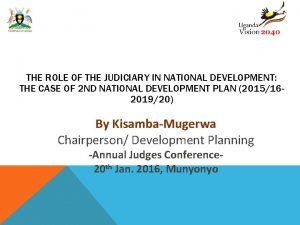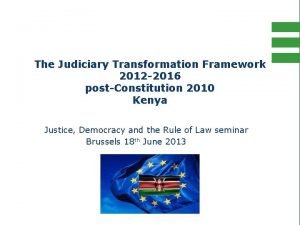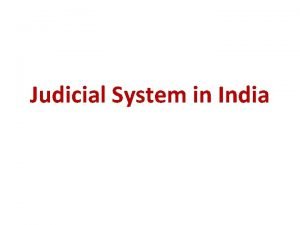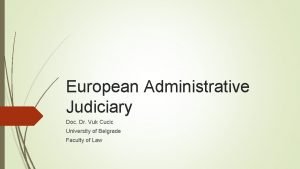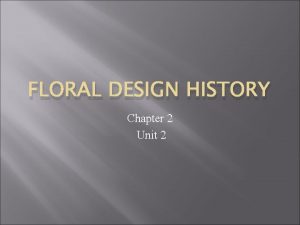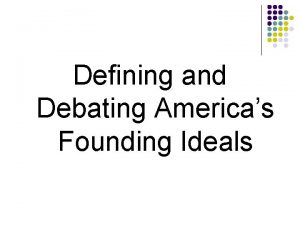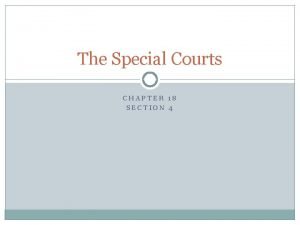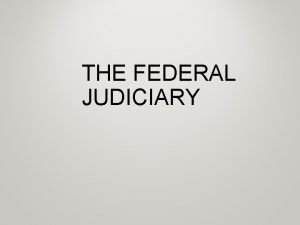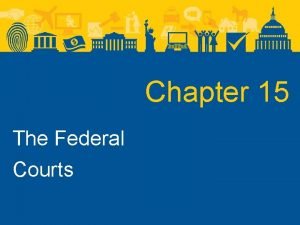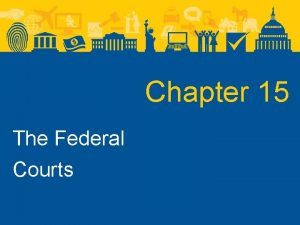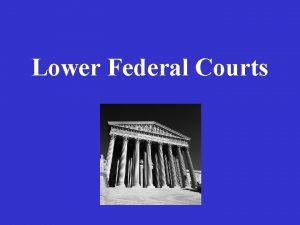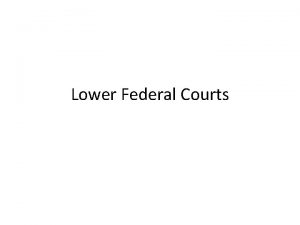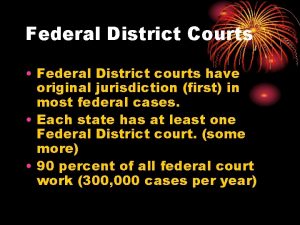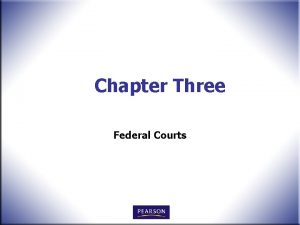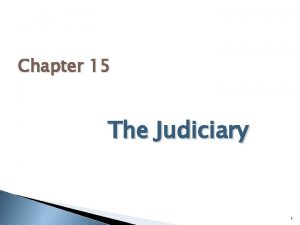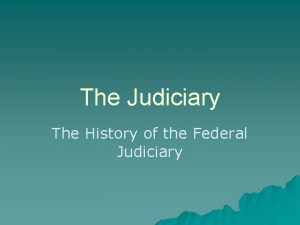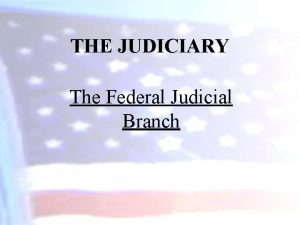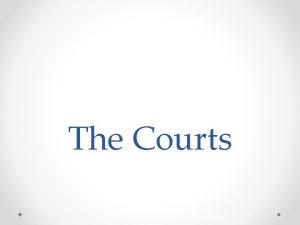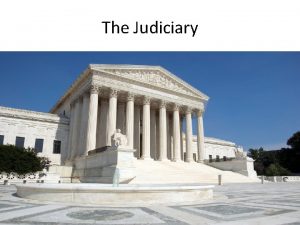The Federal Judiciary The Courts Sources of American














- Slides: 14

The Federal Judiciary The Courts

Sources of American Law Common Law- judge-made law based on unique circumstances, but based upon general principles suggested by earlier cases Precedent – Earlier cases that influence the decision making in a current case. In general, courts follow earlier precedents, but can go against them if they think earlier decisions were in error or do not apply to the circumstances of the case before them. These reversals can only occur if the previous decision came from their own court or a lower court. It’s a principle called stare decisis (to stand on earlier decisions) This is in keeping with principles of Common Law Constitutions – the supreme law of any American government, state or national, though the US Constitution is the supreme law of the land. Statutes and Regulations – laws and regulations developed by legislatures and the bureaucracy. Case Law – The collective body of court decisions that now serve to govern, thereby beign a source of law. Basically the combined effect of all earlier precedents that give us an understanding of what the law means or is. Judicial Review – the power of the Supreme court to determine the meaning of the Constitution as established by Marbury v. Madison.

The Federal Court System Basic Judicial Requirements Jurisdiction – the power of the court to make decisions involving residents of a particular geographic area. States have jurisdiction over their citizens/residents, the federal courts have jurisdiction over federal court cases that involve a federal question or diversity of citizenship Standing to Sue – in order to sue, a person must have sustained harm or have been damaged in some way by the party they are suing; furthermore, the damage must be over a justiciable controversy – meaning the damage must be real and substantial, not hypothetical or academic.

The Federal Court System (continued) Types of Federal Courts US District Courts – Trial courts of general jurisdiction Courts of Limited Jurisdiction – Courts which make decisions on cases of narrow scope Tax Courts Territorial Federal Courts Regulatory Agencies Bankruptcy Courts

The Federal Court System (continued) Types of Federal Courts (continued) Appellate Courts – Courts which only hear appeals from lower courts. These are not trial courts. The cases are decided by a panel of judges who make their decisions related to questions of law rather than questions of fact (unless the finding of the court was contrary to the facts provided in the case, or there was no evidence provided) 13 US Courts of Appeals (US Circuit Courts of Appeals) – hear appeals from the district courts and the other courts of limited jurisdiction The US Supreme Court – The highest court of appeals in the nation. It hears appeals from the District Courts of Appeals and from state Supreme Courts if they involve a federal Constitutional question. Specialized Federal Courts – specialized courts of limited jurisdiction Federal Intelligence Surveillance Act (FISA) Courts – courts that determine whether or not to issue warrants for surveillance of suspected spies and terrorists. They meet in secret, publish no opinions, and approve almost 100% of warrant requests, making them controversial

The Supreme Court Which cases reach the Supreme Court? The Supreme Court itself decides which appeals to hear; there are not automatic appeals to the court. Chances increase when different Federal District courts of Appeals have issued conflicting decisions. Chances increase if a lower court’s ruling conflicts with a Supreme Court ruling Chances increase if the ruling will have a significance beyond the parties to the dispute Pressure from the Solicitor General of the US also factors in (the Solicitor General is a high ranking appointee within the Justice Department who represents the US before the Supreme Court. Writs of Certiorari – formal requests by the Supreme Court for the court proceedings records for the Supreme Court to review by the Rule of Four. Many parties appeal to the court for a writ, but well over 90% are denied a formal hearing by the court.

The Supreme Court (continued) Deciding Cases – Once a writ of certiorari has been granted, the justices do extensive research. Each justice has four law clerks who do much of the research and preliminary drafting of opions. Oral Arguments – The Supreme Court does not hear evidence, but makes its decisions based on abstracts, the lower courts’ records and briefs filed by parties and interested parties to the case. Lawyers representing the parties do give oral arguments, and the justices ask questions of the lawyers at will. Decisions and Opinions –some time after oral arguments, the justices meet to discuss and decide the case. What the court decides, and its reasoning for the decision is called the opinion. Affirmed – a lower courts ruling was held to be correct Remanded – a lower court is sent the case back with instructions for a new trial or proceeding Reversed – a lower courts ruling was found to be in error.

The Supreme Court (continued) Opinions – the written explanations of why the court decided as it did. These are very important to the understanding of the law and its meanings for the future. Unanimous – if the judges all agree a unanimous opinion is written for the entire court. Majority Opinions- if a majority of justices agree, then an opinion is written that explains the thinking of the majority of justices. Concurring Opinions – though a majority may agree on the outcome, they may have arrived there by different reasoning. If a justice wishes to explain their different reasoning, they may write a concurring opinion. Dissenting Opinions – These are opinions written by those justices that disagree with the majority opinion, explaining why they think the majority opinion is in error. This is important as it often lays the foundation for arguments which may overturn the current opinion in the future.

Selection of Federal Judges All federal judges are appointed by the President with Senate approval There are currently more than 870 federal judgeships in the US Once appointed, judges serve for life, i. e. , until they resign, retire or die. Judges can only be removed illegal conduct, but this rarely actually happens

Selection of Federal Judges (continued) Most judicial appointees are suggested to the President via the justice department, congressmen and women, lawyers associations, etc. Competence is one factor of consideration, but so are the person’s political philosophy, ethnicity, and gender. The Process The president makes the nomination and sends the name to the Senate The Senate Judiciary Committee researches and holds hearings regarding the nominee Senatorial Courtesy allows a Senator from the state from which the judge was nominated to veto the nomination. The Senate votes to confirm or reject the nomination.

Selection of Federal Judges (continued) Federal District Court Judges – the most numerous types of judges to be appointed. Federal Courts of Appeals – There are fewer of these, but they are of greater importance as they have appellate jurisdiction and deal with more important and difficult issues of jurisprudence. Supreme Court – These are of major importance, and in recent times usually involve at least some level of rancor between the president’s and the opposition party. Nominees receive serious scrutiny and sometimes grueling testimony and confirmation hearing before Congress. Chief Justice – is not only the head of the Supreme Court, but the head of the federal judiciary (1, 200 judges, 850 magistrates, 30, 000 staff, and chairs the Judicial Conference of the US, and appoints the director of the Administrative Office of the United States Courts.

Policy Making and the Courts Judicial Activism, Loose Construction, Liberalism – These perspectives are linked together. The liberal belief in the power and ability of government to improve society result in a perspective that the Constitution and other laws should be interpreted in the light of what is best for the country (from their perspective), and need not be constrained by the letter of the law. Judicial Restraint, Strict Construction, Conservatism – These perspectives are linked together. The conservative belief in the dangers of big government result in a perspective that it should remain, as the Framers designed it, a government that is limited in its powers. The Constitution is the primary limit on government and should be interpreted, as all contracts are, according to the meanings of the words as they were written at the time the contract was signed. If the words can be interpreted to mean anything we want, and not what they meant at the time of being written, then why have a Constitution at all. Just continually remake government as you go.

Checks on the Courts The judiciary was meant to be free from political pressure, so to be able to interpret the law with objectivity and impartiality. It is not completely free from outside influence, however. Executive – Judicial implementation is dependent upon the executive branch for the implementation of its policies. Presidents influence the judiciary through their appointment power. Governors will also, at times, thwart the will of the judiciary, not implementing their decisions in their states. Legislative – Congress is responsible for the appropriation of funds required for the implementation of court decisions and can thereby thwart the will of the court. Passing constitutional amendments or rewriting laws does not really thwart the will of the court in theory, because the court is only making decisions on existing law. If new laws are made, then court decisions would understandably change as well.

Checks on the Courts (continued) Public Opinion – though technically shielded from public opinion, the court still must consider public opinions. Opinions of the court to divorced from public opinion run the risk both of having the implementation of those decisions undermined, having the public refuse to go along with the decisions, and diminish the stature of the court. It is the stature of the court that gives the court its true power, and thus, its stature must be protected. Judicial Traditions and Doctrines – Judicial traditions of common law and precedent limit what the courts may decide. To abandon these would be to abandon the foundations upon which the judiciary is built, and therefore these set real limits upon the courts. Hypothetical questions – by tradition damages must be real and substantial, not hypothetical or potential, in order for a court to rule. Political questions – the courts will also, at times, side-step cases which are primarily politically charged or motivated, and will simply let the political process determine the outcome.
 Cohesive society and preserved identity
Cohesive society and preserved identity Whats the judiciary act
Whats the judiciary act Department of judiciary
Department of judiciary Judiciary transformation framework
Judiciary transformation framework 3 types of courts in india
3 types of courts in india Jusicial restraint
Jusicial restraint Judiciary
Judiciary Print sources of information
Print sources of information Importance of water source
Importance of water source American federal floral design facts
American federal floral design facts List three types of hard goods used in floral design
List three types of hard goods used in floral design Romans floral design
Romans floral design Early american period floral design
Early american period floral design Defining and debating america's founding ideals
Defining and debating america's founding ideals The special courts
The special courts

